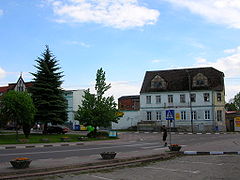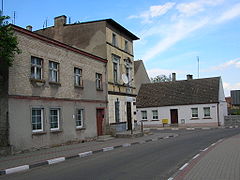
Krajenka
Encyclopedia


Town
A town is a human settlement larger than a village but smaller than a city. The size a settlement must be in order to be called a "town" varies considerably in different parts of the world, so that, for example, many American "small towns" seem to British people to be no more than villages, while...
in the Greater Poland Voivodeship
Greater Poland Voivodeship
Wielkopolska Voivodeship , or Greater Poland Voivodeship, is a voivodeship, or province, in west-central Poland. It was created on 1 January 1999 out of the former Poznań, Kalisz, Konin, Piła and Leszno Voivodeships, pursuant to the Polish local government reforms adopted in 1998...
of Poland
Poland
Poland , officially the Republic of Poland , is a country in Central Europe bordered by Germany to the west; the Czech Republic and Slovakia to the south; Ukraine, Belarus and Lithuania to the east; and the Baltic Sea and Kaliningrad Oblast, a Russian exclave, to the north...
. It has 3,804 inhabitants (2005) and lies in Złotów County.
History
The first mention of the town is from 1286, back then it belonged to noble family of Danaborskich whose Coat of Arms was Toporzyk. The name of the town itself comes from the Polish word Krajna, which meant in the past a location on the borders of Polish state. Throughout centuries it was connected to Polish royalty and such families as Danaborski, Dahlke, Kościelecki, Grudziński, Działyński, Sułkowski, Komierowskihttp://www.krajenka.pl/index.php?go=23.Magdeburg city rights
Magdeburg rights
Magdeburg Rights or Magdeburg Law were a set of German town laws regulating the degree of internal autonomy within cities and villages granted by a local ruler. Modelled and named after the laws of the German city of Magdeburg and developed during many centuries of the Holy Roman Empire, it was...
were granted in 1420 by the Polish king Władysław Jagiełło.
In the period between 1772 and 1945, following the Partitions of Poland
Partitions of Poland
The Partitions of Poland or Partitions of the Polish–Lithuanian Commonwealth took place in the second half of the 18th century and ended the existence of the Polish–Lithuanian Commonwealth, resulting in the elimination of sovereign Poland for 123 years...
, it was part of the Kingdom of Prussia
Kingdom of Prussia
The Kingdom of Prussia was a German kingdom from 1701 to 1918. Until the defeat of Germany in World War I, it comprised almost two-thirds of the area of the German Empire...
and later Germany
Germany
Germany , officially the Federal Republic of Germany , is a federal parliamentary republic in Europe. The country consists of 16 states while the capital and largest city is Berlin. Germany covers an area of 357,021 km2 and has a largely temperate seasonal climate...
, as Krojanke in West Prussia
West Prussia
West Prussia was a province of the Kingdom of Prussia from 1773–1824 and 1878–1919/20 which was created out of the earlier Polish province of Royal Prussia...
. After the last Polish owner of the town Jakub Komierowsk was killed by Prussians in 1809, the town was confiscated by Prussian officials and passed from Polish into German handshttp://www.krajenka.pl/index.php?go=23. In 1846 a Protestant church was built by the famous German architect Carl Friedrich Schinkel. In 1871 a railway station of the Prussian Eastern Railway (German: Preußische Ostbahn) was built south of the Glumia river. Krojanke then was the property of the Prussian Prince Friedrich Leopold of Prussia
Prince Friedrich Leopold of Prussia
Joachim Karl Wilhelm Friedrich Leopold Prinz von Preußen was a son of Prince Frederick Charles of Prussia and Princess Maria Anna of Anhalt-Dessau, married in 1854.- Family :On 24 June 1889 he married in Berlin Princess Louise Sophie of...
. After 1919, when neighboring areas became part of the Polish Corridor
Polish Corridor
The Polish Corridor , also known as Danzig Corridor, Corridor to the Sea or Gdańsk Corridor, was a territory located in the region of Pomerelia , which provided the Second Republic of Poland with access to the Baltic Sea, thus dividing the bulk of Germany from the province of East...
, it was made part of Grenzmark Posen-Westpreußen. On 21 June 1924, Krojanke made history within German law as the Reichsgericht
Reichsgericht
The Reichsgericht was the highest court of the Deutsches Reich. It was established on October 1, 1879 when the Reichsjustizgesetze came into effect, building a widely regarded body of jurisprudence....
confirmed private ownership by Prinz Friedrich Leopold, including Krojanke, where he died in 1931.
On 30 January 1945 the Soviet
Soviet Union
The Soviet Union , officially the Union of Soviet Socialist Republics , was a constitutionally socialist state that existed in Eurasia between 1922 and 1991....
Red Army
Red Army
The Workers' and Peasants' Red Army started out as the Soviet Union's revolutionary communist combat groups during the Russian Civil War of 1918-1922. It grew into the national army of the Soviet Union. By the 1930s the Red Army was among the largest armies in history.The "Red Army" name refers to...
occupied the almost destroyed town during World War II
World War II
World War II, or the Second World War , was a global conflict lasting from 1939 to 1945, involving most of the world's nations—including all of the great powers—eventually forming two opposing military alliances: the Allies and the Axis...
; many of the inhabitants had fled during the winter of 1944/45.After the war the town was restored to Poland in the Potsdam Conference
Potsdam Conference
The Potsdam Conference was held at Cecilienhof, the home of Crown Prince Wilhelm Hohenzollern, in Potsdam, occupied Germany, from 16 July to 2 August 1945. Participants were the Soviet Union, the United Kingdom, and the United States...
.
Its returning or remaining German
Germans
The Germans are a Germanic ethnic group native to Central Europe. The English term Germans has referred to the German-speaking population of the Holy Roman Empire since the Late Middle Ages....
population was expelled
Expulsion of Germans after World War II
The later stages of World War II, and the period after the end of that war, saw the forced migration of millions of German nationals and ethnic Germans from various European states and territories, mostly into the areas which would become post-war Germany and post-war Austria...
.
Historical population
| Year | Population |
|---|---|
| 1772 | 900 |
| 1857 | 2,061 |
| 1939 | 3,233 |
| 1945 | 150 |
| 1960 | 3,100 |
Famous residents
- Erich Wolfsfeld (1884-1956), German painter
- Siggi B. Wilzig (1926-2003), Auschwitz holocaust survivor, CEO of Wilshire Oil Company http://query.nytimes.com/gst/fullpage.html?res=9501EFDC113EF93AA35752C0A9659C8B63
- Jacob Dahlke (1689 -1750), Vodka Maker
External links
- Official website of Krajenka
- landkartenarchiv.de: Krojanke on Continental Straßenkarte Karte 15 - Bromberg map of 1921-1930

